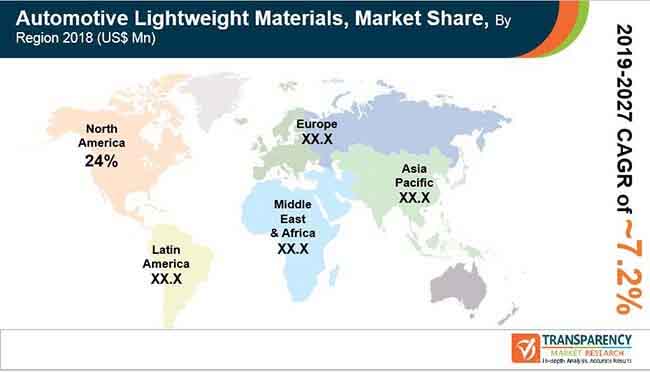Understanding Impact of COVID-19 on Automotive Lightweight Materials Market
Automotive Lightweight Materials: Description
- Automotive lightweight materials play an important role in boosting the fuel economy of automobiles. These materials also enhance safety and the overall performance of vehicles.
- The fuel efficiency of a vehicle increases if it is lighter in weight, as less energy is required to accelerate a lighter object than a heavier one. With the use of automotive lightweight materials, the fuel economy of a vehicle may improve by 6% to 8% with a 10% decrease in weight.
- Replacement of cast iron and traditional steel components with lightweight materials such as high-strength steel (HSS), magnesium and aluminum alloys, and polymer and carbon fiber composites can significantly lower the vehicle weight. This, in turn, decreases its fuel consumption.
Request PDF Brochure :https://www.transparencymarketresearch.com/sample/sample.php?flag=B&rep_id=8509
- The automotive lightweight materials market was valued at about US$ 149 Bn in 2018 and is projected to expand at a CAGR of 7.2% during the forecast period.

Request For Discount :https://www.transparencymarketresearch.com/sample/sample.php?flag=D&rep_id=8509
What are Key Growth Drivers of Global Automotive Lightweight Materials Market?
- The global automotive lightweight materials market is anticipated to expand at a significant pace during the forecast period. Growth of the market can be attributed to increase the demand for automotive lightweight materials from developing countries. Factors such as stringent government regulations and rise in the demand for automotive lightweight materials from the automotive industry are boosting the market.
- Surge in the demand for automotive lightweight materials for use in lightweight vehicles is a major driver of the market. Increasing use of lightweight materials has helped achieve higher fuel economy. The factor of weight reduction is appealing for automakers, as it tends to enhance other performance factors valued by customers. Demand for vehicles is increasing at a rapid pace, especially in developing countries.
- Mandatory emission control by governments is a major factor driving the adoption of lightweight vehicles. Emission criteria vary from region to region. In the U.S. and Canada, these are based on the vehicle size and hence, entail the incorporation of aluminum in the vehicle body. In Rest of World, these criteria are based on vehicle weight, which leads to utilization of high-strength steel.
Explore Transparency Market Research’s award-winning coverage of the global Industry:https://www.prnewswire.com/news-releases/clean-label-starch-market-to-thrive-on-the-back-of-desire-to-eat-healthy-and-awareness-about-used-ingredients-tmr-301210023.html
What are Key Challenges for Global Automotive Lightweight Materials Market?
- The cost associated with lightweight materials is high. Some lightweight materials such as carbon fiber reinforced plastics (CFRP) and glass fiber reinforced plastics (GFRP) are costly compared to other traditional materials such as steel and aluminum.
- Carbon fiber composites currently cost 1.5 to five times more than steel. High fiber production costs inhibit high volume deployment. Thus, there is a need to reduce precursor and processing costs.
- Composites offer significant improvements over metals in specific strength and stiffness, creating a myriad of opportunities. However, they are more expensive. Composites typically consist of matrix and reinforcement materials. Their cost is usually dependent on the individual prices of these two materials. Reinforcements include carbon fiber and glass fiber. The high price of carbon fibers restricts the potential use of composites in many applications. Therefore, the high cost of composites is likely to considerably restrict the market.
About Us:
Transparency Market Research is a global market intelligence company, providing global business information reports and services. Our exclusive blend of quantitative forecasting and trends analysis provides forward-looking insight for thousands of decision makers. Our experienced team of Analysts, Researchers, and Consultants, use proprietary data sources and various tools and techniques to gather, and analyze information.
Our data repository is continuously updated and revised by a team of research experts, so that it always reflects the latest trends and information. With a broad research and analysis capability, Transparency Market Research employs rigorous primary and secondary research techniques in developing distinctive data sets and research material for business reports.
Comments
Post a Comment